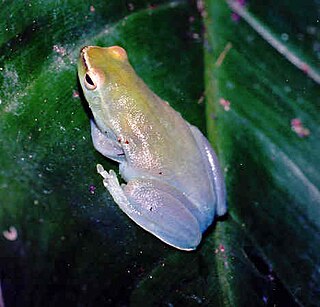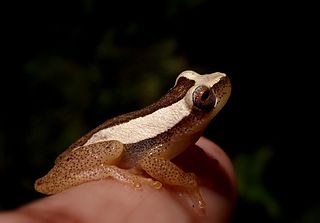
Hylidae is a wide-ranging family of frogs commonly referred to as "tree frogs and their allies". However, the hylids include a diversity of frog species, many of which do not live in trees, but are terrestrial or semiaquatic.

Sphaenorhynchus is a genus of frogs in the family Hylidae. They are also known as lime treefrogs or hatchet-faced treefrogs. They are found in the Amazon and Orinoco River basins of South America, the Guianas, Trinidad, and southern and eastern Brazil. The majority of the species are associated with the Atlantic Forest domain in Brazil.

Dendropsophus is a genus of frogs in the family Hylidae. They are distributed in Central and South America, from southern Mexico to northern Argentina and Uruguay. They are sometimes known under the common name Fitzinger neotropical treefrogs or yellow treefrogs

Aplastodiscus albosignatus, also known as the Bocaina treefrog, is a species of frog in the family Hylidae. It is endemic to Brazil. Its natural habitats are subtropical or tropical moist lowland forests, subtropical or tropical moist montane forests, and rivers. It is threatened by habitat loss.
Dendropsophus aperomeus is a species of frog in the family Hylidae. It is endemic to Peru and occurs on the Amazonian slopes of the Andes in northern and central Peru. Common name Balzapata treefrog has been coined for it.
Dendropsophus berthalutzae is a species of frog in the family Hylidae. It is endemic to southeastern Brazil and occurs in the coastal lowlands and the Serra do Mar in Espírito Santo, Minas Gerais, Rio de Janeiro, São Paulo, and eastern Paraná states. It is named in honor of Bertha Lutz, a Brazilian zoologist and feminist. Common name Bertha's treefrog has been coined for it.

Dendropsophus bogerti is a species of frog in the family Hylidae. It is endemic to the Andes of Colombia and occurs in the Cordillera Central in Antioquia, Caldas, and Chocó Departments. The specific name bogerti honors Charles Mitchill Bogert, an American herpetologist. Soon after its description in 1970, it was relegated to synonymy of Dendropsophus carnifex, but its species status was restored in 1997.

Dendropsophus ebraccatus, also known as the hourglass treefrog or pantless treefrog, is a neotropical treefrog, found scattered throughout Central and South America from southern Mexico to northern Ecuador. The common names of D. ebraccatus come from the dark hourglass shaped pattern found in the centre of the back and the distinct smooth yellow thighs that contrast the rest of the brazenly patterned body. The contrasting of the smooth yellow thighs from the rest of the bodies pattern provide the illusion that D. ebraccatus is not wearing pants. The name ebraccata in Latin means "without trousers". D. ebraccatus has a number of unique reproductive features, such as the ability to alter rates of hatching shared in a number of Anura families. D. ebraccatus is also extremely unique in its ability to alter its mode of reproduction as it is the only known vertebrate to be able to do so.

Dendropsophus haddadi is a species of frog in the family Hylidae. It is endemic to eastern Brazil, with its distribution ranging from northern Espírito Santo to Bahia, Sergipe, Alagoas, Pernambuco. The specific name haddadi honors Célio F. B. Haddad, a Brazilian ecologist and herpetologist.
Dendropsophus marmoratus is a species of frog in the family Hylidae. It is found in the Amazon rainforest and montane forests in the eastern piedmont, in Bolivia, Brazil, Colombia, Ecuador, French Guiana, Guyana, Peru, Suriname, and Venezuela. Its natural habitats are subtropical or tropical moist lowland forests, intermittent freshwater marshes, and heavily degraded former forest. "Marmoratus" in Latin means "marble," perhaps referring to the dorsal coloring pattern. It is threatened by habitat loss.
Dendropsophus melanargyreus is a species of mid-size tree frog in the family Hylidae. It is found in Bolivia, Brazil, French Guiana, Paraguay, and Suriname. Its natural habitats are subtropical or tropical dry forests, subtropical or tropical moist lowland forests, and intermittent freshwater marshes. It is threatened by habitat loss.
Dendropsophus meridianus is a species of frog in the family Hylidae. It is endemic to southeastern Brazil.

Dendropsophus phlebodes, the San Carlos treefrog or San Carlos dwarf treefrog, is a species of frog in the family Hylidae. It is found in western Colombia, Costa Rica, Nicaragua and Panama. Its natural habitats are tropical moist lowland forests, but it may also occur in disturbed habitats. It is threatened by habitat loss.

Dendropsophus robertmertensi is a species of frog in the family Hylidae. It is found in the Pacific lowlands of El Salvador, Guatemala, and southeastern Mexico. A separate population exists in the Cintalapa Valley in Chiapas.
Dendropsophus stingi is a species of frogs in the family Hylidae. It is endemic to Colombia and occurs on the eastern slope of the Cordillera Oriental in the Boyacá Department. The species was named after celebrity musician Sting in recognition of his "commitment and efforts to save the rain forest". Despite this, common name Kaplan's Garagoa treefrog has been coined for it.
Dendropsophus tintinnabulum is a species of frog in the family Hylidae. It is endemic to Brazil and only known from its type locality along the Uaupés River, "some days' journey north of Ipanoré", in the Amazonas state.

The Italian tree frog is a species of frog in the family Hylidae, found in Italy, Slovenia, Switzerland, and possibly San Marino. Its natural habitats are temperate forests, rivers, intermittent rivers, freshwater marshes, intermittent freshwater marshes, arable land, and urban areas. It is threatened by habitat loss.
Nyctimystes tyleri is a species of frog in the family Pelodryadidae, or alternatively, subfamily Pelodryadinae in the family Hylidae. It is endemic to Papua New Guinea and only known from its type locality, Gapaia Creek, between Garaina and Saureli, in the Morobe Province. The specific name honours Michael J. Tyler, an Australian herpetologist, "in recognition of his notable contributions to the systematics of Australo-papuan frogs." Common name Tyler's big-eyed treefrog has been coined for this species.

Scinax onca is a species of frog in the family Hylidae. It is endemic to Brazil and known from the middle and southern parts of the Purus–Madeira interfluvial region in the Amazonas and Rondônia states. The specific name onca is derived from the local common name for jaguar and refers to the blotchy color pattern of this frog; jaguars were also frequently spotted in the Purus–Madeira interfluvial region during the field work.
The reticulated tree frog is a species of frog in the family Hylidae. It lives in Bolivia, Peru, Ecuador and Colombia. It has been reported between 40 and 1037 meters above sea level.










